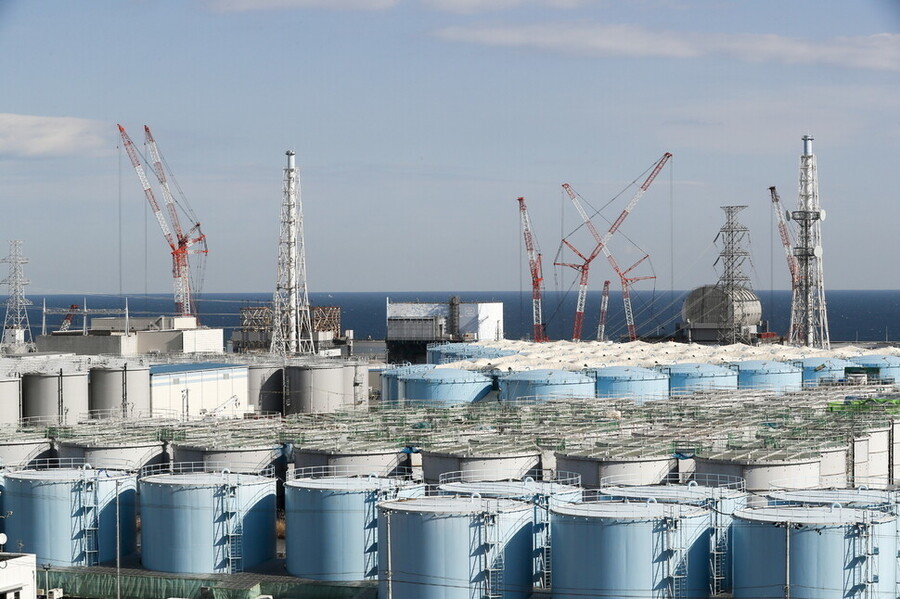Decision on the morning of the 13th at the relevant ministerial meeting
The actual discharge takes two years, such as the construction of the facilities.

Contaminated water with radioactive materials stored in tanks at the site of the Fukushima Daiichi Nuclear Power Plant. yunhap news
The Japanese government has decided to discharge the water contaminated with radioactive materials stored in tanks on the site of the Fukushima Daiichi Nuclear Power Plant into the sea. In addition to the international community, the overwhelming opposition in Japan was forced to release the sea. The actual discharge is expected to take place in two years, depending on the construction of new facilities. The Japanese government held a ministerial meeting on the morning of the 13th, lowering the radioactive substance concentration in contaminated water (about 1.25 million tons) stored in the water tank of the Fukushima Daiichi Nuclear Power Plant below the legal standard, and then discharging it to the sea for a long period (about 30 years). He said he decided to do it. Tokyo Electric Power Co., Ltd. plans to make a plan to compensate for the so-called “rumor damage” that Fukushima is a “area contaminated with radioactive materials” due to the discharge of contaminated water in the sea. The Japanese government stressed that “the policy cannot be postponed in order not to delay the decommissioning of the Fukushima nuclear power plant.” The decision was reportedly pushed by the Prime Minister’s official residence. Given the political schedule, such as the summer Tokyo Olympics and the fall of the House of Representatives elections, it seems that now is the right time to decide on contaminated water treatment. The Fukushima No. 1 nuclear power plant was shut down due to an explosion in the Great East Japan Earthquake in 2011, and decommissioning work is in progress. Contaminated water continues to increase due to nuclear fuel cooling water and groundwater and rainwater seeping into nuclear power plant buildings. Until now, about 1,000 tanks at the No. 1 nuclear power plant were storing contaminated water, but the Japanese government explained that it is difficult to store any more due to a shortage of tanks next fall. The biggest problem with ocean discharge is the safety of contaminated water. Even though TEPCO has already purified once with the “multi-nuclide removal facility” (ALPS, Alps), 70% of the contaminated water in the current tank contains radioactive substances that are deadly to the human body, such as cesium, strontium, and iodine. This fact was also revealed seven years after the accident at the Fukushima nuclear power plant. TEPCO recently announced that major radioactive materials have dropped below the standard value after secondary treatment of some of the contaminated water with’Alps’. However, the results of the secondary purification are only a small part of the total contaminated water, and specific information such as how much radioactive material remains is not disclosed. Tritium, which cannot be removed with the’Alps’, is also controversial. The Japanese government claims that other countries with nuclear facilities are also releasing water containing tritium into the sea, and no health damage has been reported. However, tritium is known to cause internal exposure when it enters the human body through aquatic products and is converted into organically bound tritium. As the impact of tritium on the human body and the environment is uncertain, it is pointed out that strict management is necessary for large-scale discharges from accident nuclear power plants like Japan over a long period of time.

Hankyoreh material photo. By Kim Jeong-hyo, staff reporter [email protected]
There are also criticisms that the Japanese government has decided from the start to “sea release,” which is inexpensive, and has not properly looked at other alternatives. Japanese civil society has proposed’mortar solidification disposal’, which is stored in large tanks on the ground or blocked with concrete. At a press conference on the 12th, a private think tank, the Nuclear Citizens’ Committee, claimed that “the government and Tokyo Electric Power did not specifically review alternative plans.” The overwhelming opposition in Japan was also ignored. Since April of last year, the Japanese government has heard opinions more than seven times with Fukushima officials and related organizations on the way to treat contaminated water, and the opposition has been overwhelmingly high. When making major policy decisions, about 70% of the Japanese government’s public comment, which was conducted by the general public, opposed sea discharge. This is the reason why criticism comes out that the Japanese government’s public opinion convergence was limited to the act of catering. Signs against’sea release’ in Japan have also been submitted to the Japanese Ministry of Economy, Trade and Industry, with 420,000 people participating. Concerns were voiced not only from Korea and China, but also from the United Nations, which are close to Japan. Five UN Special Rapporteurs who have jurisdiction over the’right to human rights and health’ made a statement on the 11th of last month, saying, “Fukushima contaminated water poses a significant risk to the environment and human rights.” Pointed out. They even delivered a letter with a statement to the Japanese government. With Japan’s decision to release contaminated water in the sea, import restrictions on Japanese agricultural, forestry and fishery products and foods in 15 countries and regions, including Korea and China, are expected to be maintained for a considerable period of time. Nine countries, including the European Union (EU) and Indonesia, require radioactive material testing certificates, and six countries, including China, Korea, Taiwan, Macau, Hong Kong, and the United States, have banned the import of some agricultural and marine products and foods. Japan is in a situation where it is demanding “eliminate it” whenever there is an opportunity such as an international conference. By Kim So-yeon, staff reporter
▶Fukushima contaminated water discharge procedure… Japanese public opinion overwhelming “opposite”
http://www.hani.co.kr/arti/international/japan/956187.html
▶Maximum 20,000 times the allowable value even for filtering out fatal substances in Fukushima contaminated water
http://www.hani.co.kr/arti/international/japan/956186.html
▶“Fukushima contaminated water is the safest to store aboveground tanks as it is now”
http://www.hani.co.kr/arti/international/international_general/956181.html
